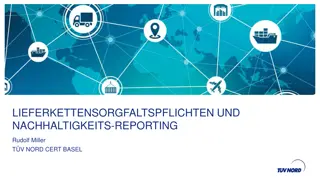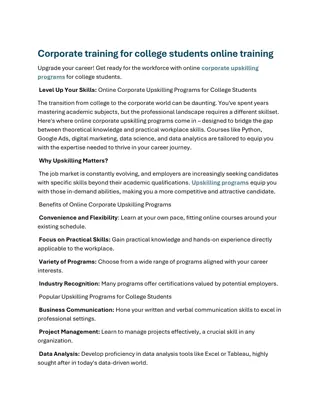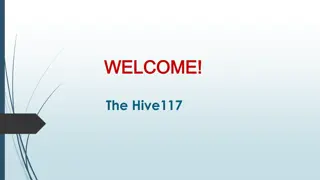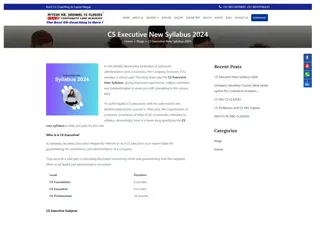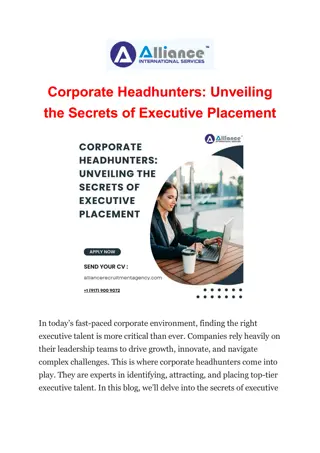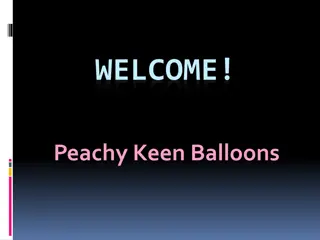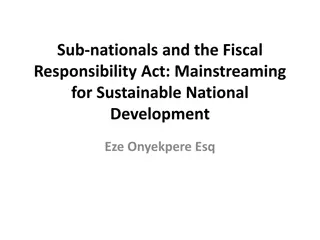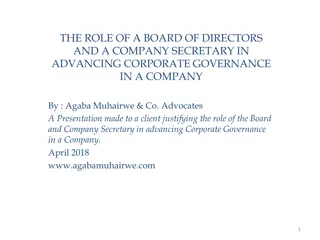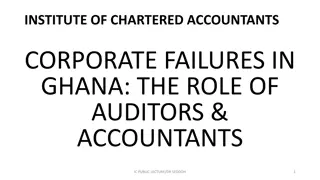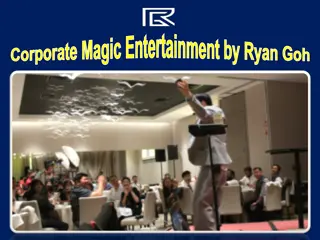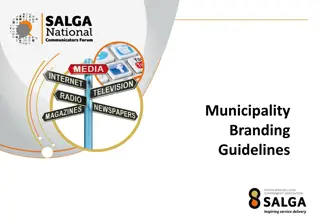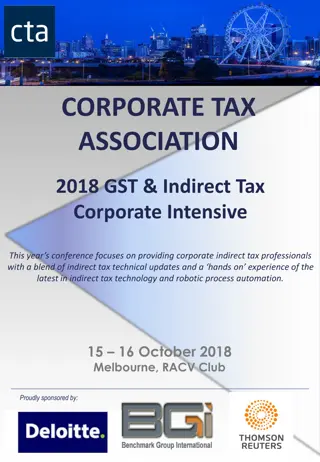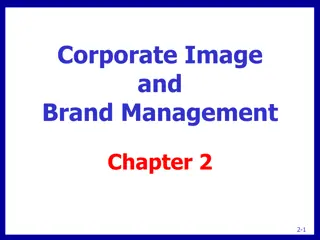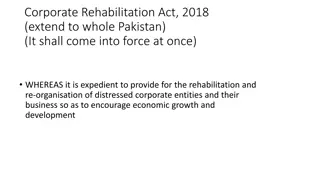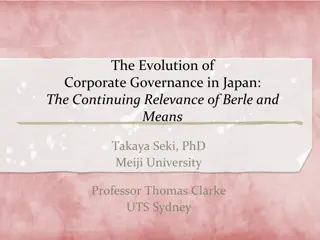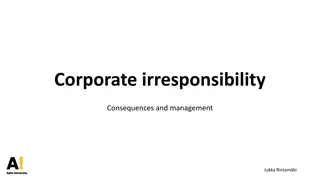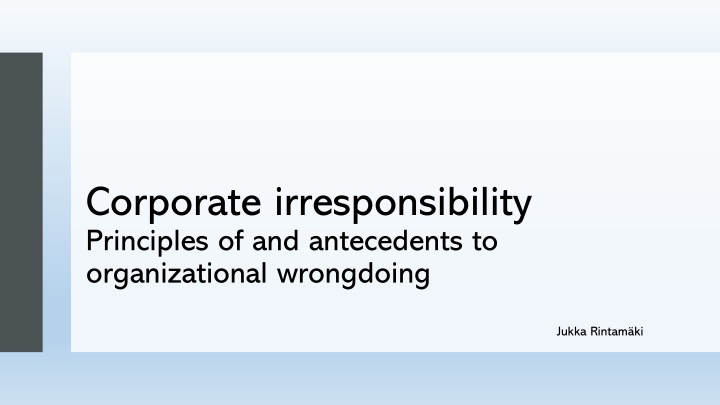
Corporate Irresponsibility and Organizational Wrongdoing
Explore the concept of corporate irresponsibility through case studies like Volkswagen's emissions scandal. Discover the antecedents to organizational wrongdoing, common occurrences, and the impact on society.
Download Presentation

Please find below an Image/Link to download the presentation.
The content on the website is provided AS IS for your information and personal use only. It may not be sold, licensed, or shared on other websites without obtaining consent from the author. If you encounter any issues during the download, it is possible that the publisher has removed the file from their server.
You are allowed to download the files provided on this website for personal or commercial use, subject to the condition that they are used lawfully. All files are the property of their respective owners.
The content on the website is provided AS IS for your information and personal use only. It may not be sold, licensed, or shared on other websites without obtaining consent from the author.
E N D
Presentation Transcript
Corporate irresponsibility Principles of and antecedents to organizational wrongdoing Jukka Rintam ki
Volkswagen Pre-2015 Poster child of corporate responsibility; widely lauded by stakeholders Ethics in Business Award by World Forum for Ethics in Business in 2012 An example of universal values such as integrity, responsibility and respect for people and the environment (CSR Europe, 2013) Aimed to become the world s most profitable, fascinating and sustainable automobile manufacturer (Muller, 2013) 2015 Embroiled in the largest corporate fraud in the history of auto industry 11 million vehicles fitted with emission cheating devices Massively higher emissions than reported (nitrogen oxide up to 40x above US limits) Violations of several different laws around the globe For a rundown, watch: https://www.youtube.com/watch?v=Y5TvFY7xRDM More information in e.g. Wikipedia
Why corporate irresponsibility? irresponsibility? Why corporate What is corporate irresponsibility? irresponsibility? What is corporate Agenda How does corporate irresponsibility come about? Normal and abnormal accounts of irresponsibility Lecture assignment
Understanding corporate irresponsibility
Why corporate irresponsibility Corporate irresponsibililty is extremely common In a given 3-year period, 40% of Fortune 100 firms have committed irresponsibility 80% of firms experience at least one crisis event in a given 5-year period Compliance, punishment, and social order are fundamental questions in any society Organizations, large ones in particular, are capable of wrongdoing with ramifications far beyond anything an individual could achieve Death, destruction (of natural habitats), hardship (loss of livelihoods), and pain (injuries) Individual level issues are important too, as wrongdoing often begins with individuals or small groups For examples of damages, see lecture notes below Source: Jackson et al., 2014
Irresponsibility, wrongdoing, misconduct... Harm Attention Attribution (of blame) Undesirability of impacts Culpability of the firm Affected party noncomplicity What is corporate irresponsibility?
Organizational misconduct Behavior in or by an organization that a social-control agent judges to transgress a line separating right from wrong; where such a line can separate legal, ethical, and socially responsible behavior from their antitheses. Greve et al., 2010. Definitions Corporate irresponsibility Organizational actions that cause harm to stakeholders. Mena et al., 2016.
Characteristics Difficult to detect Slow build-up over time See Parmalat or Enron for instance Lots of issues competing over attention See e.g. Barnett, 2014 Effectiveness of organizational secrecy Lack of transparency; watchdogs, regulators, etc. work with limited information Challenges with whistleblowing More on this next week Can emerge almost anywhere Opportunities are everywhere Limited supervision and enforcement, insufficient penalties Lots of potential drivers Most wrongdoing is conducted by normal, reasonable people trying to do well Sometimes victims of their circumstances, ethically blind etc. More on this in the next section!
Famous examples of corporate irresponsibility Ford Pinto Bhopal disaster Enron Exxon Valdez Shell Brent Spar An illuminating case on the (occasional) difficulty of determining irresponsibility BP Deepwater Horizon oil spill A pattern in oil industry? These three are just the tip of the iceberg LIBOR scandal RBS Search mis-selling or GRG, for instance VW The most severe instance in a long continuum of similar cheats Boeing 737 MAX Wirecard
Accounts of corporate wrongdoing
Abnormal wrongdoing Abnormal wrongdoing Irresponsible activity a result of deviant, unethical organizations or individuals The bad apple/barrel explanation Is corporate wrongdoing normal or abnormal? Normal wrongdoing Normal wrongdoing Irresponsible activity a result of normal, good people in challenging, complex contexts ending up doing bad things, or things with bad consequences
Wrongdoing accounts: ab/normal Wrongdoing as Wrongdoing as normal normal Wrongdoing as Wrongdoing as abnormal abnormal The social control account The accidental behavior account The rational choice account The power structure account The situational social influence account The The ethical decision account administrative system account The culture account
Wrongdoing accounts: ab/normal Wrongdoing as Wrongdoing as abnormal abnormal The rational choice account
Wrongdoing as rational choice Individuals and organizations are self-interested actors who need to be controlled so they will not choose actions that are harmful to others (while beneficial for themselves) Corporate irresponsibility as cost-benefit analysis where sometimes harmful behavior is financially profitable Employees within firms may commit acts of irresponsibility because they e.g. may potentially improve their career progression (Management) groups may commit acts of irresponsibility, because it is thought that it will not be noticed, or that the penalties will be smaller than the benefits Example: Ford Pinto
When gaps in expected/potential and actual performance appear, the likelihood of acts of irresponsibility increases Strain as a source of wrongdoing Segue to organizational level irresponsibility: Failing and marginal organizations are the likeliest offenders Not a simple matter though: Some studies find that high-growth firms are likelier than others to exhibit irresponsible behavior
Wrongdoing accounts: ab/normal Wrongdoing as Wrongdoing as abnormal abnormal The rational choice account The culture account
Culture as a source of wrongdoing Organizational cultures can can be conducive of irresponsibility or misconduct Cultures can endorse irresponsibility e.g. by emphasizing high levels of personal or collective-level achievement without specifying any related ethical considerations Cultures can permit irresponsibility in certain contexts, such as when there is no direct harm to humans involved, or that stupid customers deserve to be cheated, and so on Cultures conducive for conducting irresponsibility may be influenced by leaders, or by environmental factors For an example, read the following article on Enron s corporate culture: https://www.washingtonpost.com/archive/politics/2002/01/27/enrons- culture-fed-its-demise/d73cf80c-0d00-4281-848d-968683828ef9/
Wrongdoing accounts: ab/normal Wrongdoing as Wrongdoing as abnormal abnormal The rational choice account The ethical decision account The culture account
Wrongdoing accounts: ab/normal Wrongdoing as Wrongdoing as normal normal Wrongdoing as Wrongdoing as abnormal abnormal The rational choice account The ethical decision account The culture account
Ethical decision-making account Focus on the process of ethical decision-making Early idea, four stages: (Fail to) become aware of need for ethical consideration Deliberate and (fail to) identify the ethical course of action (Fail to) develop intention to act consistently with that course (Fail to) act in accordance Useful, but assumes a vacuum for decision-making More recent work in this strand have emphasized the need for context, limits of rationality, the need to consider emotions, intuition, temporality, and so on Perhaps most useful for demonstrating how difficult it is to reach an ethically sound decision in a complex context
Wrongdoing accounts: ab/normal Wrongdoing as Wrongdoing as normal normal Wrongdoing as Wrongdoing as abnormal abnormal The rational choice account The The ethical decision account administrative system account The culture account
The administrative system account Administrative systems: Obtrusive controls such as division of labor, rules, and standard operating procedures Explicit guidelines that tell managers and employees what to do in specific situations Sometimes, such explicit obtrusive controls prevent or hamper individual (moral/ethical) judgment Unobtrusive controls such as professional roles (and creeds), (restrictive) communication channels, information processing technologies, and schemas Less explicit guidelines, help navigating where obtrusive controls do not reach Sometimes these un/obtrusive controls lead to wrongdoing!
Wrongdoing accounts: ab/normal Wrongdoing as Wrongdoing as normal normal Wrongdoing as Wrongdoing as abnormal abnormal The rational choice account The situational social influence account The The ethical decision account administrative system account The culture account
The situational social influence account Social relationships provide information about the attitudes and behaviors that are appropriate for the work environment The idea is to support attitudes and behaviors that facilitate desired organizational outcomes Peer influence has been shown to e.g. cause employees work harder and better than they otherwise would Sometimes, things go awry, however Among professional cyclists, cyclists whose teammates use doping, are more likely to engage in use of doping than those whose teammates do not use doping Also other types of related phenomena such as groupthink or commitment processes
Wrongdoing accounts: ab/normal Wrongdoing as Wrongdoing as normal normal Wrongdoing as Wrongdoing as abnormal abnormal The rational choice account The power structure account The situational social influence account The The ethical decision account administrative system account The culture account
The power structure account Power structures establish a pecking order that provides direction for employees when confronted with tasks or problems For instance, a chain of command Gives employees the possibility to turn to their superiors, but also to managers to exert control over subordinates But also more informal structures Such as someone in an organization controlling access to a scarce resource Power structures also hold potential dangers Dangers of compliance Milgram experiment: administering electrical shocks Abuse of power in organizations The Stanford prison experiment by Zimbardo et al. Though be aware of the post-hoc re-evaluations of the prison experiment!
Wrongdoing accounts: ab/normal Wrongdoing as Wrongdoing as normal normal Wrongdoing as Wrongdoing as abnormal abnormal The accidental behavior account The rational choice account The power structure account The situational social influence account The The ethical decision account administrative system account The culture account
The accidental behavior account Sometimes, a specific phenomenon-related explanation is difficult to find Environments may change, we may misinterpret things or miscommunicate etc. And as a result our actions may have unintended consequences The (technological) systems we work in/with can become extremely complex and tightly coupled The outcomes are still wrongful and cause harm, and thus such activity can be considered misconduct
Wrongdoing accounts: ab/normal Wrongdoing as Wrongdoing as normal normal Wrongdoing as Wrongdoing as abnormal abnormal The social control account The accidental behavior account The rational choice account The power structure account The situational social influence account The The ethical decision account administrative system account The culture account
The social control account Social control agents most typically the state or a similar actor have an influence on, or in fact generate organizational wrongdoing What is demarcated as right or wrong is always decided by these agents, and they may change the bases for such evaluations over time and space They may come up with rules and regulations that are difficult to follow or interpret Organizations may inadvertently end up crossing the line from right to wrong They may otherwise come up with rules and regulations, or otherwise incentivize actors or organizations to transgress
Wrongdoing accounts: ab/normal Wrongdoing as Wrongdoing as normal normal Wrongdoing as Wrongdoing as abnormal abnormal The social control account The accidental behavior account The rational choice account The power structure account The situational social influence account The The ethical decision account administrative system account The culture account
A few words on combating organizational wrongdoing
How to combat wrongdoing risks: Generally Be aware of the ubiquity and normality of wrongdoing; how easily and the different ways it comes about Be aware that preventing and dealing with organizational wrongdoing is very complex and difficult; across the board measures are difficult to come by, but context-specific measures are possible Generate understanding across all levels of the organization, managers especially, on the different aspects (accounts) of organizational wrongdoing
How to combat wrongdoing risks: More specifically 1 2 3 4 Minimize incentive system (rational choice) related misconduct Hire people with tempered preference structures, provide incentive systems that encourage rightdoing (discourage wrongdoing), monitor wrongdoing through governance Minimize culture- related misconduct Hire people with the right values, endorse cultural values that support rightdoing (discredit wrongdoing), have the right types of leaders Minimize power- related misconduct Good followership: it is ok to challenge superior as well as to obey them; spread power around instead of focusing it Minimize administrative system facilitated wrongdoing Be aware of unintended consequences of admin systems, encourage reflexivity
Recap Corporate irresponsibility/wrongdoing is common, and in many cases more complex than simply evil Can be seen as either a normal or an abnormal feature of organizational activity Can be summarized to be a result of an interplay between personal traits of the decision-maker and characteristics of the situation Decision-making hardly rational in the first place, and obstructed and distracted by a variety of factors and issues Thus, the path following which decisions have been arrived at tend to be highly case-specific This does not mean, however, that there are no safeguards against
References Barnett, M. L. 2014. Why Stakeholders Ignore Firm Misconduct: A Cognitive View. Journal of Management Journal of Management, 40(3): 676 702. CSR Europe 2013. Volkswagen wins international sustainability award. CSR Europe CSR Europe, 9 January 2013 (http:// www.csreurope.org/volkswagen-wins-international-sustainability-award#.Vhr1x_mqqko). Gioia, D. A. 1992. Pinto fires and personal ethics: A script analysis of missed opportunities. Journal of Business Ethics Journal of Business Ethics, 11(5 6): 379 389. Greve, H. R., Palmer, D., & Pozner, J. 2010. Organizations Gone Wild: The Causes, Processes, and Consequences of Organizational Misconduct. The Academy of Management Annals The Academy of Management Annals, 4(1): 53 107. Jackson, G., Brammer, S., Karpoff, J. M., Lange, D., Zavyalova, A., et al. 2014. Grey Areas: Corporate Reputation and Irresponsible Corporations. Socio Socio- -Economic Review Economic Review, 12(January): 153 218. Lange, D., & Washburn, N. T. 2012. Understanding Attributions of Corporate Social Irresponsibility. Academy of Management Review Academy of Management Review, 37(2): 300 326. Mena, S., Rintamaki, J., Fleming, P., & Spicer, A. 2016. On the forgetting of corporate irresponsibility. Academy of Management Review Academy of Management Review, 41(4): 720 738. Muller, J. 2013. How Volkswagen will rule the world. Forbes harder/). Forbes, 17 April 2013 (http://www.forbes.com/ sites/joannmuller/2013/04/17/volkswagens-mission-to-dominate-global-auto-industry-gets-noticeably- Palazzo, G., Krings, F., & Hoffrage, U. 2011. Ethical Blindness. Journal of Business Ethics Journal of Business Ethics, 109(3): 323 338. Palmer, D. A. 2013. The New Perspective on Organizational Wrongdoing. California Management Review California Management Review, 56(1): 5 24. Palmer, D. 2012. Normal organizational wrongdoing: A critical analysis of theories of misconduct in and by organizations Normal organizational wrongdoing: A critical analysis of theories of misconduct in and by organizations. Oxford University Press. Palmer, D., & Yenkey, C. B. 2015. Drugs, sweat, and gears: An organizational analysis of performance-enhancing drug use in the 2010 tour de France. Social Forces Social Forces, 94(2): 891 922. Perrow, C. 1984. Normal accidents: Living with high risk technologies. Normal accidents: Living with high risk technologies. Princeton University Press. Rhodes, C. 2016. Democratic Business Ethics: Volkswagen s Emissions Scandal and the Disruption of Corporate Sovereignty. Organization Studies Organization Studies, 37(10): 1501 1518.
Lecture assignment Apply different accounts to a case of wrongdoing
Lecture assignment Work as individuals Choose an instance of corporate irresponsibility What happened? To what extent is the case normal / abnormal wrongdoing? Which different types of accounts are present? Any dominant ones? Can you find anything on whether the wrongdoing could have been prevented? Or lessons learned? Choose one from the following: Boeing 737 MAX Wells Fargo false accounts scandal Toyota accelerator pedal scandal Wirecard

